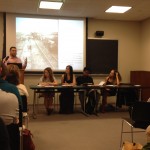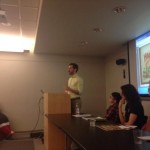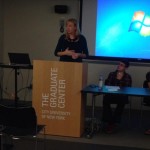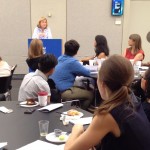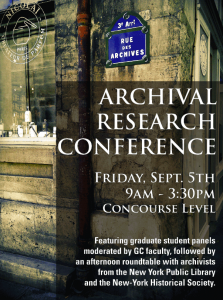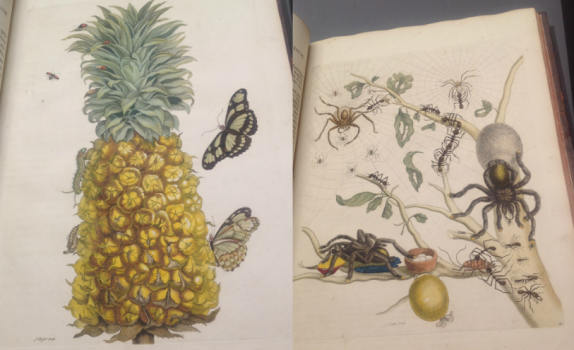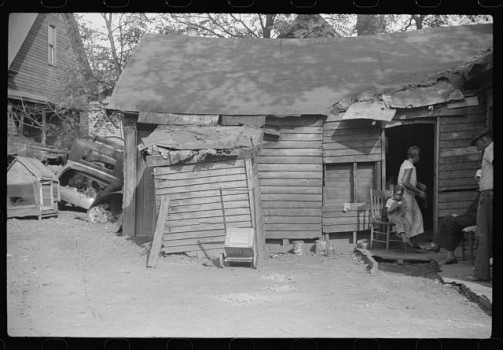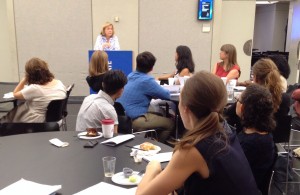 Friday, September 5th, 2014
Friday, September 5th, 2014
CUNY Graduate Center
#GCArchivalResearch
The Graduate Center’s first Archival Research Conference featured student recipients of one of several different fellowships funded by the Provost’s office: the Lost & Found Stipends Program, the Provost’s Digital Innovation Grants, The Advanced Research Collaborative Award for Archival Research in African American and African Diaspora Studies, and The Advanced Research Collaborative Knickerbocker Award for Archival Research in American Studies. Panels moderated by Graduate Center faculty were followed by an afternoon roundtable featuring New York Public Library and New-York Historical Society archivists discussing the collections they curate.
Photos from the conference (via Twitter and Christopher Eng):
In order to showcase the type of research being funded by the Provost’s Office, some of the student presenters have graciously provided their presentations for this conference archive:
- Sean Gerrity (English): Uncovering the Literature and History of US Slave Marronage in the Great Dismal Swamp: An Archival Study at the University of Virginia
- Diana Epelbaum (English): ‘I own I love the vegitable world extremly’: The Gender of Genre and Women’s Natural History Writing, 1688-1808
The full conference schedule and program follows below.
Schedule
9:00-9:20am — Welcoming Remarks
- Duncan Faherty (English and American Studies)
- Provost Louise Lennihan
9:20 – 10:20am — Panel Session I
10:20 – 10:30am — Break
10:30 – 11:30am — Panel Session II
11:30 – 12:15pm — Lunch
12:15 – 1:15pm — Panel Session III
1:15 – 1:30pm — Break
1:30 – 2:30pm — NYC Archivists Roundtable (Elebash Recital Hall)
2:30 – 3:30pm — Reception (Elebash Lobby)
Panel Session I — 9:20-10:20am
C205 — Aesthetics, Politics, and Difference
Chair: Kandice Chuh (English)
- Denisse Andrade* (Earth & Environmental Sciences, Geography)
“The Black Radical Movement and the Poetics and Politics of Land” - Paul Fess* (English)
“Slavery and Anti-slavery: Sound and Text” - Tonya M. Foster* (English)
“Umbra Writers’ Workshop: Archives and Extensions—Tom Dent” - Saisha Grayson* (Art History)
“Cellist, Catalyst, Collaborator: The Work of Charlotte Moorman, 1963-1980″ - Stefanie A Jones* (Theatre)
“Acts of Provocation: Racial Formation and Twenty-First Century U.S. Commercial Theatre”
C203 — Print Culture and Canon Formation in the Early Republic
Chair: William Kelly (English)
- Brian Baaki* (English)
“The Black Criminal in Early American Print Culture” - Courtney Chatellier* (English)
“Archival Research in Early American Literature” - Nora Slonimsky* (History)
“‘The Engine of Free Expression’ [?]: The Political Development of Copyright in the Colonial British Atlantic and Early National United States” - Nicole Zeftel* (Comparative Literature)
“‘The Economics and Poetics’ of the Nineteenth Century Dime Novel”
C197 — Mining Alternative Geographies of Race and Labor
Chair: Herman Bennett (History)
- Hector Agredano* (Earth & Environmental Sciences, Geography)
“Railroads, Railroad Workers and Geographies of the Mexican Revolution of 1910″ - Gordon Randolph Barnes Jr.* (History)
“Imperial Fears: Planter Ideology, Violence, and the Post-Emancipation Experience in the British Empire, 1800-1900″ - Megan Brown* (History)
“Which Integration for Algeria? Eurafrica and the Treaty of Rome” - Jenny LeRoy* (English)
“Capitalizing on the Global South: Eliza McHatton’s Hemispheric Plantation Economy” - Frances Tran* (English)
“Traces of the Coolie: An Archival Encounter”
C201 — Sexuality, Politics, and the Archive
Chair: Alyson Cole (Political Science)
- Meredith Benjamin* (English)
“Engaging Feminism’s Archive” - Elizabeth Decker* (English)
“Recovering Edith Summers Kelley” - Margaret Galvan* (English)
“Watching Out for Dykes in Activist Archives and Special Collections” - Alisa Wade Harrison* (History)
“An Alliance of Ladies: Power, Public Affairs, and Gendered Constructions of the Upper Class in Early National New York City” - Wen Liu* (Psychology)
“Untying the Knot: Archiving the Marriage Equality Movements in Taiwan, China, and the US as Recent History”
Break — 10:20-10:30am
Panel Session II — 10:30-11:30am
C201 — Cultures of Political Economy
Chair: Jessie Daniels (Psychology)
- Flannery Amdahl* (Political Science)
“Big Brother’s Keepers: Liberal Religious Organizations and the Development of the American Welfare State” - Velina Manolova* (English)
“Queer Interventions in Racial Liberalism in the Writings of Lillian Smith, Carson McCullers, James Baldwin, and Lorraine Hansberry, 1944-1970″ - David McCarthy* (Historical Musicology)
“The Appearance of the Comedy LP (1957-1973)” - Adam McMahon* (Political Science)
“President-Led American State Unbuilding 1953-2013″ - Sara Rutkowski* (English)
“The Federal Writers’ Project and its Influence on African American Literature”
C203 — Critical Pedagogies: Rewriting of Knowledge Production
Chair: Steve Brier (Urban Education)
- Nolan Chessman* (English)
“A Pedagogy of Possibility: Adrienne Rich in the Age of Open Admissions” - Diana L. Epelbaum* (English)
“‘I own I love the vegitable world extremly’: The Gender of Genre and Women’s Natural History Writing, 1688-1808″ - Naja Berg Hougaard* (Psychology, Human Development)
“The Past is Not Dead: Resuscitating the Forgotten History of Danish Colonialism in the U.S. Virgin Islands” - Laura Kaplan* (Urban Education)
“The History and Development of P.S. 25″
C197 — Representing Geographies of the Urban and the Rural
Chair: Cindi Katz (Earth & Environmental Sciences)
- Jacob Cohen* (Music)
“Experiences of New England: Urban and Rural in the Music of Chadwick, Ives, Ruggles and Crawford Seeger” - Nicholas Gamso* (English)
“Race, Cities, and American New Wave Documentary of the 1960s and 70s” - Marjorie Gorsline* (Anthropology)
“An Archaeology of Accountability: Race, Power, and Privilege in the Rural Northeast” - Cara Jordan* (Art History)
“Joseph Beuys and Social Sculpture in the United States: Rick Low and Ongoing Residency” - Katherine Uva* (History)
“Dawn of a New Day: New York City Between the Fairs”
C205 — Forum on Digital Initiatives and Fellowships
Chair: Matthew K. Gold (English)
- Amanda Licastro† (English)
“The Writing Studies Tree” - Natascia Boeri† (Sociology)
“Community IT Centers and Organizing Women Workers in Gujarat, India” - Micki Kaufman† (History)
“Quantifying Kissinger”
Lunch — 11:30am-12:15pm
Panel Session III — 12:15-1:15pm
C197 — Diasporic Cultures and Identity Formation
Chair: Sujatha Fernandes (Sociology)
- Anahí Douglas* (English)
“African American Ex-pats and Exiles in Mexico” - Aídah Gil* (History)
“Arthur, Arturo, and the Archive: A History of a Historical Imagination” - Abigail Lapin* (Art History)
“Afro-Brazilian Art, Architecture and the Civil Rights Movement in Brazil, 1960s-80s” - Rocío Gil Martínez de Escobar* (Anthropology)
“Bordering States, Bordering Race: Afro-Indigenous Struggles for Recognition in the Coahuila-Texas Borderland”
C203 — The Performances of Citizenship and National Belonging
Chair: Eric Lott (English)
- Devora Geller* (Musicology)
“Mamele on the Yiddish Stage and Screen” - Sissi Liu* (Theatre)
“Monkey King Performances as Alternative Discourse of Asian Americanness” - Kristin Moriah* (English)
“Dark Stars of the Evening: Performances of African American Citizenship and Identity in Germany, 1890-1930″ - Melissa Phruksachart* (English)
“Cherry Blossoms in Bryant Park: Mediating Asiatic Racialization on Cold War Television” - Hallie Scott* (Art History)
“The Driftwood Village and the Truckin’ University: Experimental Architecture Education on the West Coast, c. 1970″
C205 — The Long Project of Abolition & Black Radical Resistance
Chair: Donald Robotham (Anthropology)
- Laura Bini Carter* (Anthropology)
“Embodied & Inscribed—Gwoka: Guadeloupan Social Movement and UNESCO Immaterial Heritage of France” - Sean Gerrity* (English)
“Uncovering the Literature and History of U.S. Slave Marronage: An Archival Study in Virginia and North Carolina” - Timothy M. Griffiths* (English)
“Other Black Households: The Archives of Queer Black Affective Formations” - Lydia Pelot-Hobbs* (Earth & Environmental Sciences, Geography)
“The Consolidation of the Louisiana Carceral State, 1970-1995″ - Wendy Tronrud* (English)
“Buried Alive: Researching William Walker and Thomas Gaines”
C201 — Lost and Found
Chair: Ammiel Alcalay (English)
- Lauren Bailey‡ (English)
- Philip Griffith‡ (French)
- Gabrielle Kappes‡ (English)
- Kai Krienke‡ (Comparative Literature)
- Megan Paslawski‡ (English)
- Alex Wermer-Colan‡ (English)
Break — 1:15-1:30pm
NYC Archivists Roundtable — 1:30-2:30pm
Elebash Recital Hall
Welcoming Remarks by President Chase Robinson
Chair: Polly Thistlethwaite, Chief Librarian CUNY Graduate Center
Panelists:
- Steven G. Fullwood – Assistant Curator, Manuscripts, Archives and Rare Books Division, Schomburg Center for Research in Black Culture, New York Public Library
- Bob Kosovsky – Curator, Rare Books and Manuscripts, Music Division, The New York Public Library for the Performing Arts
- Marilyn Satin Kushner – Curator and Head, Department of Prints, Photographs, and Architectural Collections New-York Historical Society
- Thomas Lannon – Assistant Curator, The New York Public Library Manuscripts and Archives Division
- Edward O’Reilly – Curator and Head, Manuscript Department, Patricia D. Klingenstein Library, New-York Historical Society
- Mary F. Yearwood – Curator, Photographs and Prints Division, Schomburg Center for Research in Black Culture, New York Public Library
Reception — 2:30-3:30pm
Elebash Lobby
* ARC Archival Research Grant Recipients
Names marked with an asterisk (*) received research funding through the ARC Knickerbocker Archival Research Grant in American Studies or the ARC Archival Research Grant in African American and African Diaspora Studies.
Additional grant recipients not listed above:
- Vanessa Burrows (History)
“The Medicalization of Stress: Hans Selye and the Transformation of the Postwar Medical Marketplace” - Omar Ramadan-Santiago (Anthropology)
Performing the Third Race: Rastafari and the Racial Imagination in Puerto Rico
† Provost’s Digital Innovation Grant Recipients
Names marked with a dagger (†) received funding through the Provost’s Digital Innovations Grant Program for the 2013-14 academic year.
‡Lost & Found Stipend Recipients
Names marked with a double dagger (‡) received funding through the Center for the Humanities Lost & Found Stipend Program for the 2013-14 year.


